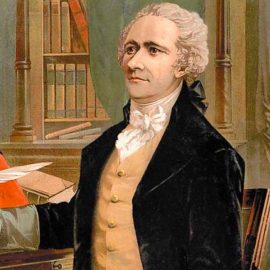

This article is an excerpt from the Shortform book guide to "Guns, Germs, and Steel" by Jared Diamond. Shortform has the world's best summaries and analyses of books you should be reading.
Like this article? Sign up for a free trial here .
What factors contributed to the rise and spread of knowledge in Eurasia? What advantages did knowledge provide in Eurasian society?
According to Jared Diamond, the author of Guns, Germs, and Steel, three factors lead to the spread of knowledge in the history of Eurasia. Those factors were: a head start in food production, a large area with a dense population, and the ease of diffusion.
Continue reading to learn the history of how Eurasia thrived.
3 Factors That Aided Rise and Spread of Knowledge
Diamond identifies three factors that contributed to the rise and spread of knowledge in the history of Eurasia:
1. Early onset of food production: Food production led to the development and spread of knowledge because it created food surpluses and increased population density. Because Eurasia had a head start on food production, it had a head start on creating these conditions.
(Shortform note: Researchers have found that the earliest cities in the world (such as Uruk, the main city in The Epic of Gilgamesh) emerged first in the Fertile Crescent. This suggests that the early onset of agriculture may have influenced population density there.)
Having extra food meant that a society could support non-farming specialists—such as craftspeople and bureaucrats—who could focus their time and energy on advancing their specialized knowledge. Craftspeople who may initially have developed specialized tools for farming, for example, could in time develop specialized weapons for warfare. Likewise, bureaucrats responsible for organizing harvests and building projects had to keep records and collect and transfer information: According to Diamond, this was a necessary condition for the invention of written language.
(Shortform note: Research supports Diamond’s idea that record-keeping and transferring information were necessary preconditions for the invention of written language. Scholars find that the earliest precursor to writing was used for transferring numerical (how much) and categorical (what type) information. Tokens were simply objects, such as a shell or a special stone, that were used to represent a quantity and type of object (for example, a jar of grain or three fish). This earliest use of non-spoken language indicates that one condition leading to the invention of written language was the need to quantify information and relay it accurately.)
In hunter-gatherer societies, by contrast, all members of the society had to spend most of their time and energy on collecting enough food to survive, so they weren’t free to advance their knowledge in other areas, and they had little use for innovations such as written language.
(Shortform note: Because hunter-gatherer societies shared the responsibility for foraging equally, there were no sharp distinctions between members of the society. Experts argue that the practice of food production changed this, causing an unequal social division of labor: Not only did specialists emerge, but tasks also began to split along gender and age lines in a way that wasn’t seen before.)
2. Large area and population size: We’ve already seen that Eurasia had earlier and better food production than other continents, but it also happened to be the largest continent by far, and larger continents could support larger populations. Having more people provided more opportunities for ideas to arise and spread.
Diamond explains that Eurasia (including North Africa) is nearly eight million square miles (21 million km2) larger than the next largest continent group: North and South America. Similarly, the current population of Eurasia is many times larger than any other continent. While the ancient population size isn’t known, Diamond contends that Eurasia likely had the largest population in the past, also.
(Shortform note: Estimates show that the combined population of Asia and Europe (Eurasia) was greater than any other continent from at least as early as 10,000 BCE and has remained so up to the present. Furthermore, current measurements of Eurasia’s landmass (including North Africa) indicate that it’s around 56 million km2. The landmass of the Americas is over 42 million km2. While this 14 million km2 difference isn’t identical to Diamond’s figure, rounding errors and other variations may account for the discrepancy: For instance, Diamond never defines what areas he includes in North Africa. Nevertheless, Eurasia is larger and more populous than the Americas by any definition—this is consistent with Diamond’s argument.)
3. Ease of diffusion: The same reasons that gave Eurasia advantages in the spread of food production gave it the upper hand in the diffusion of knowledge: a dominant east-west axis and fewer geographic obstructions.
A dominant east-west axis free of major obstructions facilitated the spread of knowledge because knowledge moved with people. As groups crossed Eurasia and set up farms and villages, they brought ideas and skills with them. Once new ideas emerged, they replaced or corrected old ideas and stimulated more new ideas, which led to more innovation.
(Shortform note: Recent studies back up Diamond’s hypothesis that an east-west (E-W) axis made the diffusion of knowledge easier. In an analysis of ancient and early modern technology adoption, researchers found that technologies spread more quickly along an E-W axis than along a north-south axis. Another recent study indicates that languages change more readily along an E-W axis, as well.)
Because of these factors, Diamond believes Eurasia had an advantage over other regions of the world for advancing knowledge since any idea that arose was more likely to spread and develop across a large network of people.
(Shortform note: Researchers observe that knowledge spreads through the diffusion of ideas and the migration of people. Population size and density have been shown to affect the rate of this spread, suggesting that Eurasia did have an advantage over less populous regions.)
The Advantage of Knowledge
History tells us that Eurasians developed advanced knowledge leading to innovations that gave them advantages over societies whose knowledge was more limited, writes Diamond.
Some of these key innovations were: durable metal weapons, armor, and tools; efficient means of transport such as the wheel and oceangoing ships; navigational equipment; and written language. When Eurasians traveled across the ocean to the Americas, their metal armor and guns were superior to the wood, bone, leather, and stone weapons and armor of the indigenous peoples. Moreover, the written languages of the Eurasians facilitated clear communication, which both inspired and coordinated expeditions and conquest. For these and other reasons, the invaders quickly subdued the Native Americans despite their having been established on the continent for millennia.
(Shortform note: Some scholars believe that Diamond has sugarcoated colonialism and contributed to the destructive spirit of conquest. The problem with Diamond’s view, as they see it, is that he makes conquest and colonialism an inevitable outcome of the environment’s effects on societies—some people just end up with all the advantages. Because of this, they argue that colonizers and conquerors are let off the hook.)

———End of Preview———
Like what you just read? Read the rest of the world's best book summary and analysis of Jared Diamond's "Guns, Germs, and Steel" at Shortform .
Here's what you'll find in our full Guns, Germs, and Steel summary :
- An in-depth look into why societies historically took different paths
- The environmental factors that affected the historical development of those societies
- Why Eurasians had strategic advantages over non-Eurasians






